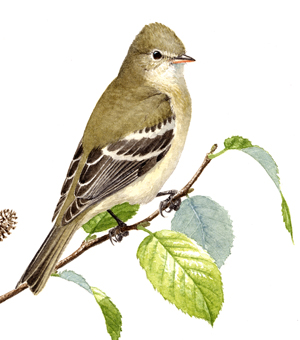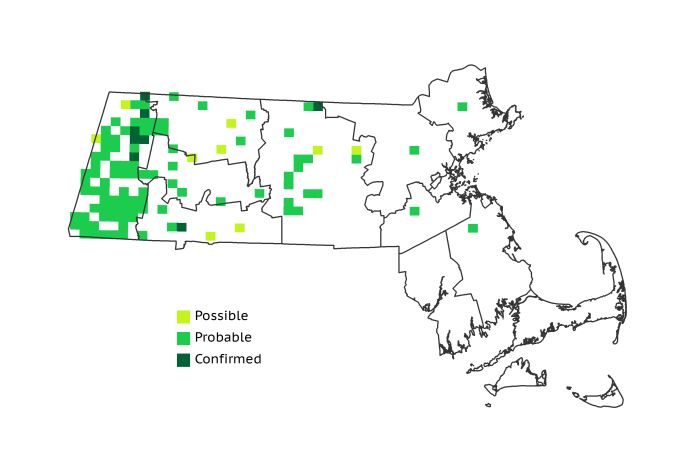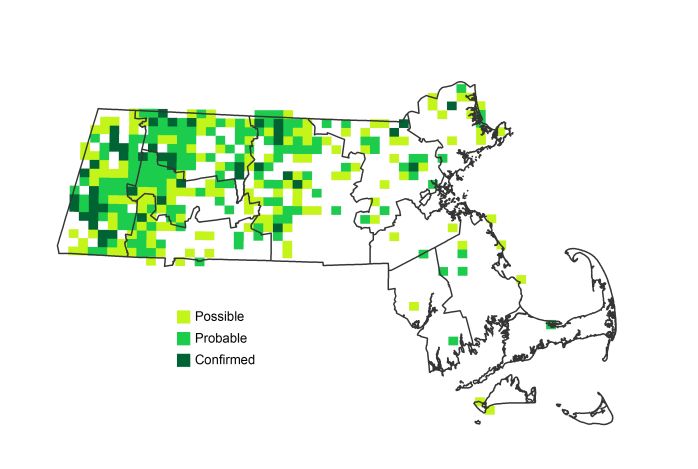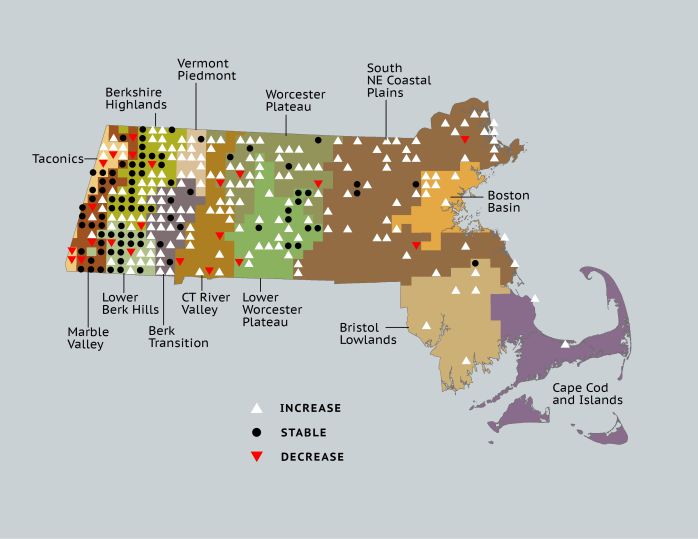Breeding Bird Atlases (BBA)
Find a Bird
Alder Flycatcher
Empidonax alnorum

Somewhat local and strongly increasing
“Fee-bee-o!” – Alder Flycatcher
The Empidonax complex – a genus of small, drab flycatchers – can be difficult for all but the most experienced birders to differentiate visually. Even the master birders balk at separating Alder and Willow Flycatchers by sight. These two birds are so visually indistinguishable that they were considered the same species until about 40 years ago. As is so often the case with this genus, the keys to correct identification are voice and habitat. Alder Flycatchers prefer to make their homes at the brushy margins of swamps, often among swales of alder.
Historic Status
The bewilderment in properly identifying Willow and Alder Flycatchers, the song-separated versions of what was called the Traill’s Flycatcher until 1973, predates the woes of modern-day birders and ornithologists. Accordingly, confusion has historically reigned as to the exact breeding range of the Alder Flycatcher. One Massachusetts birder, J.A. Farley, took them on as a special cause in the early days of the twentieth century and suggested that they bred in the eastern part of the state more than they had historically been credited for doing (Farley 1901). Farley left us with the confusing summary that Alder Flycatchers were relatively quiet, late in migrating, and subsisting on foods found in places typically hidden from obvious view. “While always breeding sparingly,” said Farley, it “is not so rare a summer bird in the eastern part of Massachusetts as it is commonly supposed to be” (Farley 1901).
Atlas 1 Distribution
Though it may previously have been the dominant resident of the Traill’s Flycatcher complex in Massachusetts, the Alder Flycatcher’s distribution in Atlas 1 reflected the effects of colonization by the Willow Flycatcher, which moved into the state from the south and predominated in many of the low-lying areas of the Commonwealth. Scrubby wetlands and alder swamps throughout the western part of the state hosted most of the breeding Alder Flycatchers found during the first Atlas period. The Taconic Mountains had Alder Flycatchers in 44% (7 out of 16) of blocks, and breeding evidence was found in 64% (25 of 39) of blocks in the Marble Valleys. The Berkshire Highlands and Lower Berkshire Hills also had 45% or better breeding Alder Flycatcher occupancy. The bird’s distribution was spotty in the Connecticut River Valley, but somewhat more concentrated across the Worcester and Lower Worcester Plateau regions. Collectively, all the eastern ecoregions accounted for only 5% of the species’ Atlas 1 distribution.
Atlas 2 Distribution and Change
The Atlas 2 distribution of Alder Flycatchers was distinguished by a marked eastward expansion. Regions such as the Marble Valleys and Lower Berkshire Hills where the species was already widespread underwent modest increases, but the numbers skyrocketed in the Berkshire Highlands, Berkshire Transition, and Vermont Piedmont regions. Although the Connecticut River Valley remained less favored by this species, the Worcester Plateau and Lower Worcester Plateau experienced a notable increase of occupied blocks for Alder Flycatcher breeding activity. Overall more than 45 new blocks in the Coastal Plains reported evidence of breeding Alder Flycatchers, and the Boston Basin and the Bristol/Narragansett Lowlands regions, where they had been only marginally present in Atlas 1, also had the species in several blocks. Even the Cape and Islands as far out as Martha’s Vineyard had sporadic summer sightings.
Atlas 1 Map

Atlas 2 Map

Atlas Change Map

Ecoregion Data
Atlas 1 | Atlas 2 | Change | ||||||
Ecoregion | # Blocks | % Blocks | % of Range | # Blocks | % Blocks | % of Range | Change in # Blocks | Change in % Blocks |
Taconic Mountains | 7 | 43.8 | 6.4 | 10 | 40.0 | 2.9 | 1 | 6.7 |
Marble Valleys/Housatonic Valley | 25 | 64.1 | 22.7 | 26 | 66.7 | 7.6 | 1 | 2.6 |
Berkshire Highlands | 25 | 45.5 | 22.7 | 48 | 87.3 | 14.0 | 21 | 39.6 |
Lower Berkshire Hills | 17 | 60.7 | 15.5 | 25 | 80.6 | 7.3 | 7 | 25.9 |
Vermont Piedmont | 1 | 5.9 | 0.9 | 15 | 88.2 | 4.4 | 9 | 75.0 |
Berkshire Transition | 6 | 15.8 | 5.5 | 35 | 87.5 | 10.2 | 22 | 71.0 |
Connecticut River Valley | 3 | 5.4 | 2.7 | 20 | 30.8 | 5.8 | 11 | 22.9 |
Worcester Plateau | 8 | 10.3 | 7.3 | 57 | 64.8 | 16.6 | 24 | 50.0 |
Lower Worcester Plateau | 12 | 16.2 | 10.9 | 38 | 47.5 | 11.0 | 17 | 31.5 |
S. New England Coastal Plains and Hills | 5 | 1.9 | 4.5 | 52 | 18.4 | 15.1 | 39 | 17.3 |
Boston Basin | 0 | 0.0 | 0.0 | 8 | 14.3 | 2.3 | 8 | 14.5 |
Bristol and Narragansett Lowlands | 1 | 0.9 | 0.9 | 6 | 5.3 | 1.7 | 5 | 5.0 |
Cape Cod and Islands | 0 | 0.0 | 0.0 | 4 | 2.8 | 1.2 | 2 | 1.7 |
Statewide Total | 110 | 11.4 | 100.0 | 344 | 33.2 | 100.0 | 167 | 20.1 |
Notes
While our Massachusetts Alder Flycatchers are definitely expanding in both footprint and abundance, the news is clearly not positive throughout the species’ eastern range. The Alder Flycatcher shows a significant increasing Breeding Bird Survey trend in Massachusetts, but a significant decreasing Breeding Bird Survey trend in the Eastern US overall.



